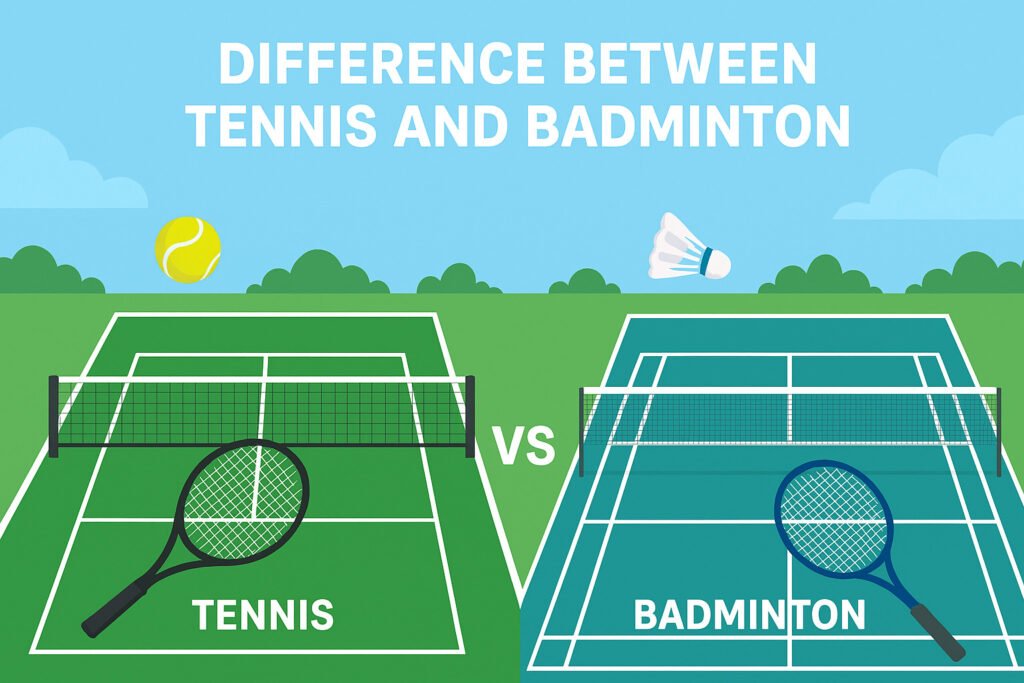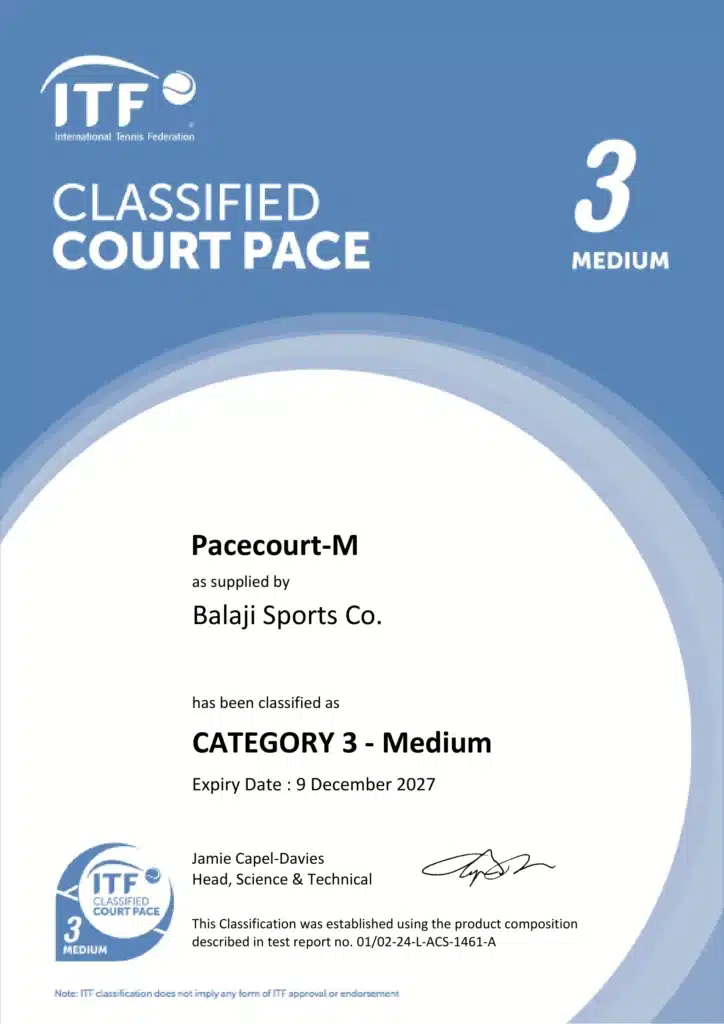Difference Between Tennis and Badminton: Which One Should You Play?
Tennis and badminton are two of the world’s most popular racket sports, loved by players of all ages for their energy, strategy, and excitement. While both involve rackets, nets, and a court, the similarities end there — each sport has its own unique rules, equipment, and style of play. Understanding the difference between tennis and badminton helps players appreciate how each game challenges the body and mind in distinct ways. Tennis is often seen as a game of endurance, power, and long rallies played on larger outdoor courts, whereas badminton is known for its speed, precision, and agility, usually played indoors. Both sports require skill, coordination, and fitness, but the way they challenge the body and mind differs significantly. In this blog, we’ll explore the key differences between tennis and badminton, including their court designs, equipment, scoring systems, and playing techniques. Whether you’re a beginner trying to decide which sport to learn or simply curious about how they compare, this guide will help you understand what sets these two iconic games apart. What is Tennis? Tennis is a globally recognized sport that combines strength, strategy, and endurance. It can be played individually (singles) or in teams of two (doubles). Players use a stringed racket to hit a felt-covered rubber ball over a net, aiming to land it within the opponent’s court. The game originated in the late 19th century and has evolved into one of the most prestigious sports, featuring iconic tournaments such as Wimbledon, the US Open, and the French Open. Tennis can be played on various surfaces, including clay, grass, and synthetic hard courts, each influencing the speed and bounce of the ball. Physically, tennis demands explosive movements, stamina, and power, while mentally it requires tactical thinking and patience. The sport is not only a test of athleticism but also of consistency and control. What is Badminton Badminton is a fast-paced indoor racket sport that emphasizes agility, quick reflexes, and precision. Instead of a ball, players hit a shuttlecock (or birdie) — a lightweight projectile made of feathers or synthetic materials — across a high net using a light, flexible racket. The game can also be played as singles or doubles, with matches typically being shorter and more intense than tennis. Originating from ancient games played in India and later refined in England, badminton has grown into a major sport in Asia, particularly in India, China, and Indonesia. Badminton courts are smaller than tennis courts, allowing for rapid rallies and frequent directional changes. It requires exceptional hand-eye coordination, speed, and endurance in short bursts. While tennis is often played outdoors, badminton is mostly played indoors to avoid wind interference, ensuring the shuttlecock’s flight remains stable. In short: Both offer unique physical and mental challenges, making them two of the most engaging sports worldwide. Court Differences One of the most noticeable distinctions between tennis and badminton lies in the court size, surface type, and setup. Although both games involve a net and boundaries, the design and dimensions of each court cater to the sport’s unique style of play. Tennis Court A tennis court is much larger and designed for powerful groundstrokes and long rallies. The court surface can vary — clay, grass, or synthetic hard court — each offering a different bounce and playing speed. A larger court area demands greater endurance and lateral movement, as players must cover more ground with every rally. Badminton Court A badminton court, by contrast, is smaller and built for fast-paced exchanges and quick reflexes. The flooring is usually wooden or synthetic acrylic, providing a smooth, non-slip surface ideal for indoor play. Badminton’s smaller court promotes speed, precision, and agility, with players constantly moving in short, explosive bursts. Quick Comparison Table Feature Tennis Court Badminton Court Length 23.77 m 13.4 m Width (Singles/Doubles) 8.23 m / 10.97 m 5.18 m / 6.1 m Net Height 1.07 m 1.55 m Surface Type Clay, Grass, Synthetic Acrylic Wooden, Synthetic Acrylic Environment Mostly Outdoor Mostly Indoor Movement Style Long rallies, powerful strokes Quick rallies, rapid footwork Equipment Differences While tennis and badminton may appear similar at first glance — both requiring rackets and a net — their equipment is designed very differently to suit the pace, technique, and dynamics of each sport. Every piece of gear, from the racket to the footwear, is specialized to enhance performance and comfort on the court. 🎾 Tennis Equipment Tennis is a power-oriented sport that demands strong, durable equipment to handle high-speed ball impacts and longer rallies. 🏸 Badminton Equipment Badminton focuses on speed, precision, and quick reflexes, so its equipment is lighter and more flexible. Equipment Tennis Badminton Racket Weight 250–340 grams 80–100 grams Playing Object Rubber ball Shuttlecock (feather/synthetic) Average Object Weight 56–59 grams 4.75–5.50 grams String Tension 50–65 lbs 18–30 lbs Court Footwear Durable, outdoor grip Lightweight, indoor non-marking Primary Focus Power, control, endurance Speed, agility, precision Gameplay and Scoring Differences Though tennis and badminton are both racket sports, their rules, scoring systems, and playing styles are entirely different. Each sport tests players’ skills, stamina, and reflexes in unique ways — with tennis emphasizing long rallies and power, while badminton focuses on speed and precision. 🎾 Tennis Gameplay and Scoring Tennis matches are built around rallies in which players strike a ball back and forth over the net, aiming to land it inside the opponent’s court. A point is scored when the opponent fails to return the ball correctly. Key Aspects of Gameplay: Scoring System:Tennis uses a unique point structure based on “games” and “sets.” Example:If the score is 6–4, 5–7, 6–3 → the player wins 2 sets to 1. Tennis rallies are generally longer and slower, requiring stamina, strategy, and power over extended play. 🏸 Badminton Gameplay and Scoring Badminton, in contrast, is a fast-paced indoor game where points are won through quick reflexes, smart shot placement, and agility. The goal is to hit the shuttlecock so that it lands in the opponent’s court before they can return it. Key Aspects of Gameplay: Scoring System:Badminton




